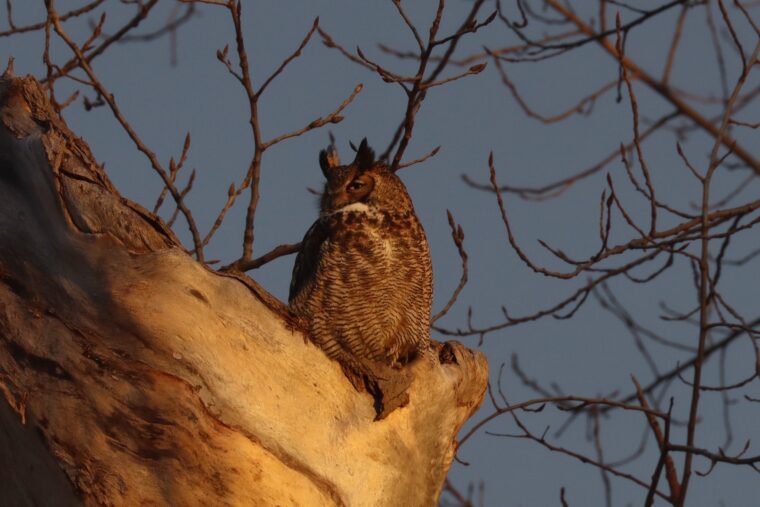Scene
‘Up & Atom!’: Mark Glenshaw’s lecture on the owls of Forest Park was a hoot

Photo courtesy of Mark Glenshaw
On a warm August evening in 2005, the sun was setting over Forest Park. The breeze carried the scent of blooming flowers, and the usual birdsong filled the air until it was interrupted by an unexpected sound — a hoot. Mark Glenshaw, a former faculty member of WashU’s Brown School and writer for Student Life during his time as a WashU student, who was taking an evening stroll, paused. He had no idea that moment would change his life forever.
“If you had asked me 20 years ago to talk to you about owls, we would have been done in like two minutes,” Glenshaw said. “They were nowhere on my radar. But that first night — I mean, that literally changed my life.”
Glenshaw quickly spotted the source of the hoot: a great horned owl he would come to know as Charles. “I thought, ‘Oh my God, I have to learn everything I can about great horned owls,’” he said. And he did.
Since 2005, he has observed and documented the daily lives of these nocturnal birds, analyzing their behaviors, habitats, and social patterns with meticulous care. Nearly two decades later on April 9, Glenshaw — also known as the “Owl Man” — brought his extensive knowledge to the University City Public Library, where he gave a dynamic lecture on the owls of Forest Park.
“I typically get out there six to seven nights a week, over 300 nights a year,” Glenshaw said.
His main subject is Charles, a 21-year-old great horned owl believed to have spent his entire life in Forest Park. Glenshaw’s lecture highlighted Charles’ routines — his feeding habits, mating rituals, and most notably, his distinct patterns of flying.
“My favorite part is observing how predictably unpredictable it is,” Glenshaw said. “Every night is different, every night is unique.”
To illustrate this, Glenshaw shared a collection of photos and videos capturing Charles’ behavior. One crowd favorite showed the owl appearing to take a “shower” in the rain, flapping and shaking in a way that mirrored human actions. These small moments helped the audience connect with the owls on a deeper level.
“I have often seen the Owl Man in Forest Park, on walks with my friend Elaine,” audience member Mary Anne Modzelewski said. “I found his lecture so impressive, and the different behaviors of the owls are so fascinating to watch.”
Bibi Vandenbreock, an audience member and wildlife enthusiast, was drawn to the lecture after encountering an owl in her home garden.
“I thought to myself: I love photography. I love wildlife. I like Forest Park. Why not go and listen? And I can learn something,” she said.
For fellow attendee Sarah Stauffer, the most surprising takeaway was just how large the birds are and how fast they grow.
“I didn’t realize they were so big. The way that they grow so quickly from a tiny little egg to 18 inches tall in less than two months — that’s amazing,” she said.
Also impressive were the physical abilities of the birds which Glenshaw emphasized during his lecture.
“They’ll go 20 to 40 miles per hour. I’ve seen them do 200 yards in 10 seconds. Olympic sprinters do 100 yards in 10 seconds,” he explained.
His personal favorite behavior to observe, though, is flight. “It’s a fascinating optical illusion,” Glenshaw said. “It’s so powerful, fast, and so ethereal that even having seen it thousands of times, there’s still an element of ‘I don’t believe my own eyes.’”
Among those in attendance was Modzelewski’s friend Elaine Arthur, who recalled reading about Glenshaw years ago, but never followed up until now. “I saw something online that he was going to be speaking tonight, and I thought, this is my opportunity. I’m not going to put this off any longer. And it was well worth it,” she said.
After so many years of observing Charles and his mates, Glenshaw has developed a unique sense of understanding with the owl.
“There have been moments where I have felt a connection,” he said. “Even if there is recognition and maybe a slight degree of trust, I never take this for granted. I try to earn it and build on it every time I’m there.”
He likens their relationship to giving a good presentation: preparation, presence, and care all matter.
“When I go to give a lecture, I’m gonna do my best to be on time, be prepared, and be a good presenter,” Glenshaw said. “So when I’m with the owls, I’m doing my best to be that good guest for them too.”
Glenshaw used his lecture to emphasize the importance of connecting with nature — whether that means venturing into Forest Park or simply taking a mindful walk through your own neighborhood. For him, owls are not just mysterious, elusive creatures; they are powerful ambassadors for the natural world.
“I think one of the most important things is that since you don’t see them as much, it’s important to know more about something you don’t see,” he said. “These are hugely important animals ecologically. They’re fascinating on so many levels, they are attractive on so many levels, aesthetically, and scientifically.”
He also noted that owls have held a unique place in human imagination for centuries.
“People are fascinated about owls. Across human history and human culture, people respond to owls very strongly,” he said.
For Glenshaw, following Charles and his fellow owls is not just a hobby: It’s a lifelong commitment to understanding and sharing the quiet wonder of the world, just beyond our gaze.
“Owls are a great gateway to learning more about nature, ecology, and conservation,” Glenshaw said. All we have to do is choose to take the step.
